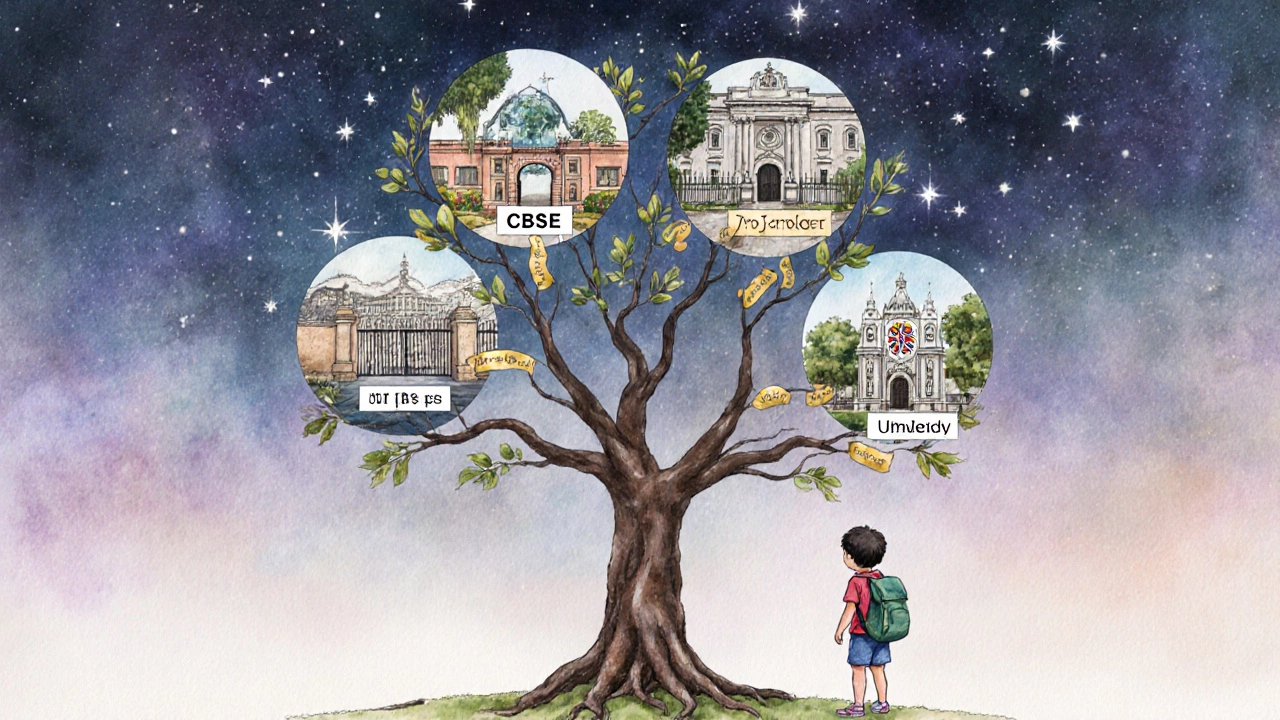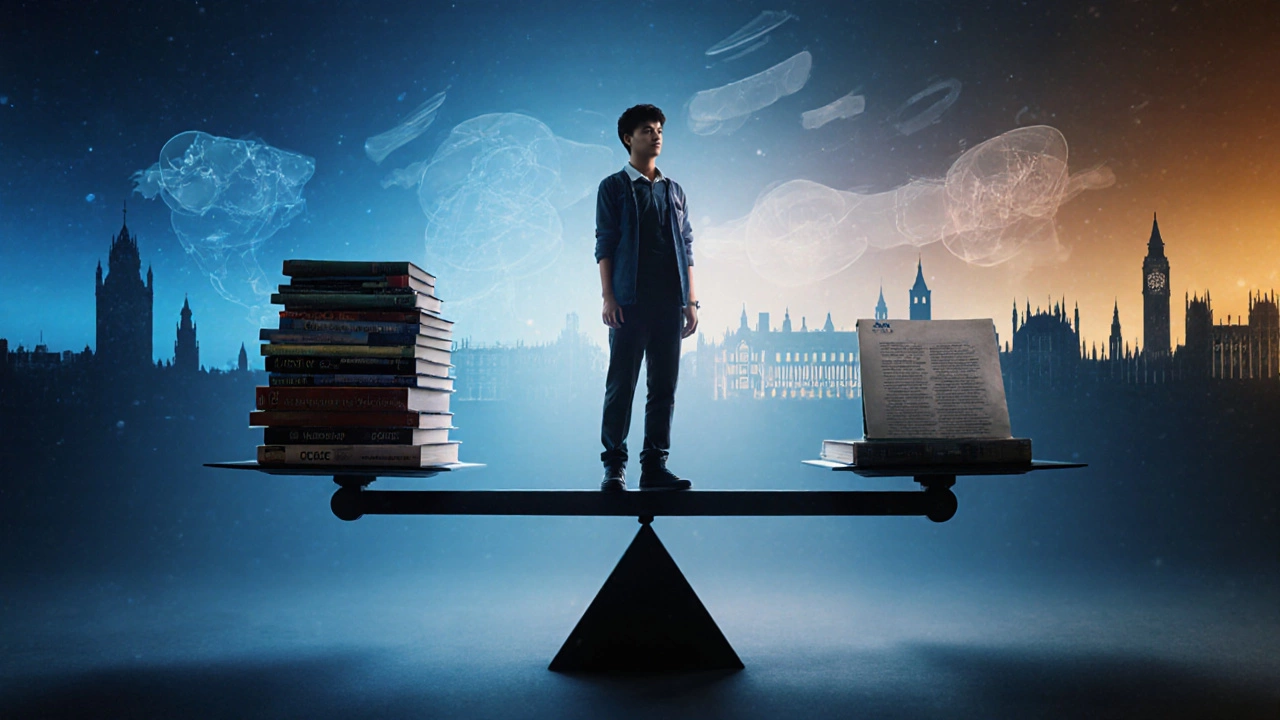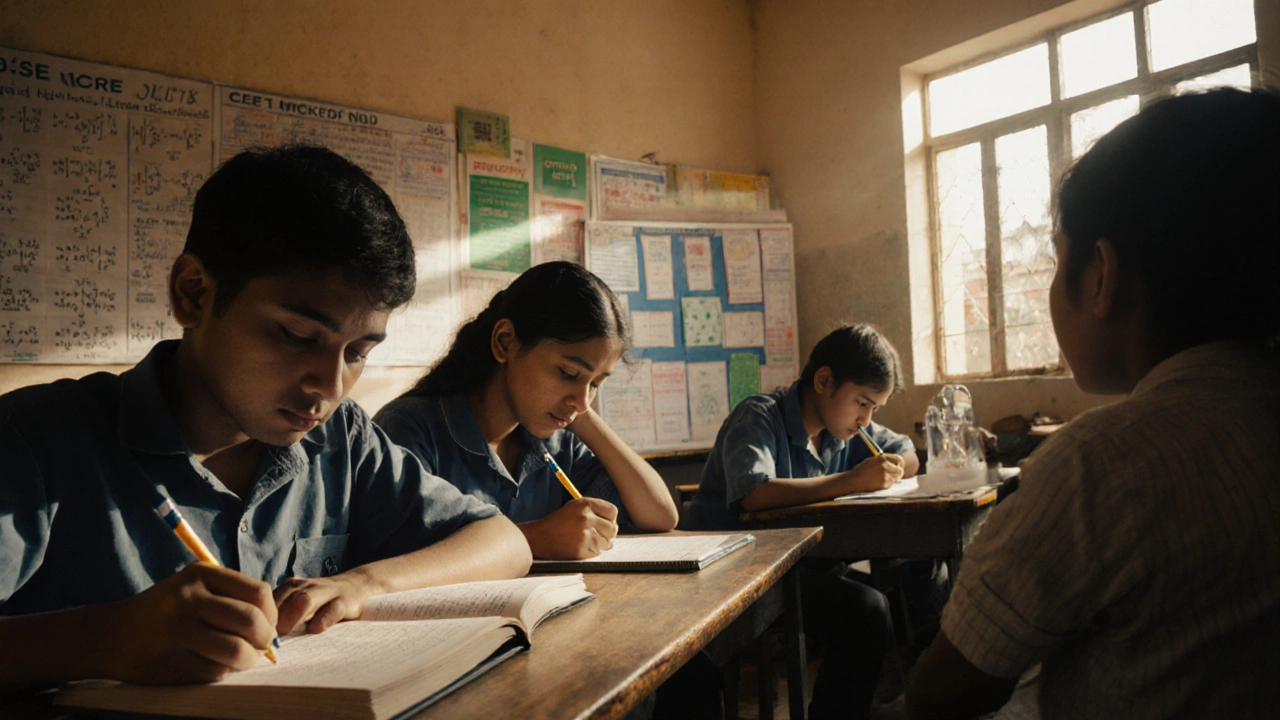Syllabus Fit Calculator
Find the best education board for your child
Answer a few questions to discover which syllabus is the best fit for your child's goals, learning style, and budget.
Your child's goals
Learning style
Budget considerations
Recommended Syllabus
Why this fit? This recommendation is based on your child's goals, learning style, and budget. It aligns with what the article emphasizes about finding the right match rather than chasing prestige.
Key considerations
There’s no single "best" syllabus in the world - but there is a best one for your child’s goals, learning style, and future path. The CBSE syllabus dominates India with over 20,000 affiliated schools, but it’s not the only option. Parents often ask: Is CBSE better than IB? Is Cambridge more respected abroad? Do state boards prepare kids for real life? The answer isn’t about rankings - it’s about fit.
What makes a syllabus "best"?
A good syllabus doesn’t just cover topics. It shapes how students think. The best ones build problem-solving skills, encourage curiosity, and prepare learners for real-world challenges - not just exams. Some focus on memorization. Others push critical thinking. Some are rigid. Others let students explore. The "best" syllabus depends on what you want your child to become.
For example, a student aiming for engineering in India might thrive under CBSE because its math and science structure aligns directly with JEE and NEET exams. But a child planning to study environmental science at a university in Canada? They’ll need the IB’s research-based approach and global perspective. There’s no universal winner. Only the right match.
CBSE syllabus: India’s most popular choice
The Central Board of Secondary Education (CBSE) is the backbone of school education in India. It serves over 25 million students across the country and in 200+ schools abroad. Its syllabus is standardized, predictable, and heavily focused on core subjects: Mathematics, Science, English, and Social Science.
CBSE’s biggest strength is its exam alignment. From Class 10 to Class 12, the pattern of questions - multiple choice, short answer, long answer - mirrors national entrance exams. This means students spend less time adjusting to test formats and more time mastering content. The NCERT textbooks, which CBSE uses as the base, are clear, concise, and widely available.
But CBSE has limits. It doesn’t emphasize creativity or independent research. Projects are often formulaic. Critical thinking is secondary to accuracy. If your child thrives on open-ended questions, group discussions, or real-world projects, CBSE might feel too rigid.
IB Diploma Programme: Global readiness
The International Baccalaureate (IB) Diploma Programme is designed for students who plan to study abroad. It’s offered in over 5,000 schools worldwide, including top institutions in the UK, US, Australia, and Singapore. Unlike CBSE, IB doesn’t just test knowledge - it tests how you use it.
IB students complete six subjects across disciplines: languages, sciences, math, arts, and humanities. They also write a 4,000-word Extended Essay, take a Theory of Knowledge course, and complete 150 hours of Creativity, Activity, Service (CAS). These aren’t add-ons - they’re core requirements.
IB is harder. The workload is heavier. Grading is stricter. But it builds skills no other syllabus matches: research, time management, independent analysis, and cross-cultural communication. Universities like Oxford, Harvard, and ETH Zurich actively prefer IB applicants because they know these students can handle university-level work from day one.
IB isn’t for everyone. It’s expensive. It requires strong English fluency. And it doesn’t align with India’s competitive exams like JEE or NEET. If your child wants to study engineering in India, IB won’t give them an edge - it might even slow them down.

Cambridge (CIE): The British alternative
The Cambridge International Examinations (CIE) syllabus is the UK’s global export. It’s offered in over 10,000 schools worldwide and is especially popular in India among families targeting UK universities.
Cambridge’s IGCSE (Class 10) and A-Levels (Class 12) are modular. Students pick 4-5 subjects to specialize in - no forced science or arts mix. This lets them focus on what they love. A student interested in literature can drop physics. A math whiz can skip art. That flexibility is rare.
Cambridge exams are known for depth over breadth. Questions demand analysis, not recall. For example, instead of asking “What is Newton’s Third Law?”, a Cambridge paper might ask: “A rocket launches from Earth. Use Newton’s laws to explain why it moves upward despite gravity.” That’s applied thinking.
Cambridge is respected globally. But like IB, it doesn’t prepare students for India’s entrance exams. And its cost is high - often double or triple CBSE fees. It’s best for families with clear international plans.
State Board syllabi: Local relevance, uneven quality
Each Indian state has its own board - Maharashtra (MSBSHSE), Tamil Nadu (TNBSE), Uttar Pradesh (UPMSP), and so on. These syllabi are often more aligned with local languages, culture, and regional needs.
Some state boards, like Maharashtra’s, have improved significantly in recent years. Others still rely on outdated textbooks and rote learning. The quality varies wildly. A student in Delhi might get a stronger science curriculum than one in Bihar, simply because of funding and teacher training.
State boards are cheaper and more accessible. They’re ideal for families who plan to stay in-state for college or want their child to learn in their mother tongue. But if your child aims for national-level exams or universities abroad, state boards may leave gaps in English proficiency, lab skills, or international exposure.
How to choose: A practical decision tree
Stop asking “Which is best?” Start asking:
- Where does your child want to study after Class 12? If it’s India - engineering, medicine, or law - CBSE is the safest bet. If it’s the US, UK, Canada, or Australia - IB or Cambridge wins.
- How does your child learn? Do they thrive on structure and clear answers? CBSE fits. Do they ask “Why?” and want to explore? IB or Cambridge will challenge them.
- What’s your budget? CBSE and state boards cost under ₹50,000/year. IB and Cambridge can cost ₹3-8 lakhs/year. Don’t choose a syllabus that breaks your finances unless the payoff is clear.
- What’s your long-term goal? Is it a high-paying job in India? CBSE gets you there fastest. Is it a global career? IB or Cambridge opens more doors.
Many families make the mistake of choosing based on reputation alone. “IB is elite,” they say. But elite doesn’t mean better for your child. A student who hates writing essays won’t succeed in IB - no matter how prestigious it is.

What do universities really want?
Top universities don’t care if you’re from CBSE or IB. They care about your grades, your projects, your essays, and your ability to think independently.
A 2023 study by the University of Cambridge analyzed 12,000 international applicants. It found no significant difference in first-year performance between IB, CBSE, and Cambridge students - as long as their grades were comparable. What separated the top performers? They had done independent research, led a club, or solved a real problem in their community.
That’s the real lesson. The syllabus is just the vehicle. What matters is what the student does with it.
Final verdict: No single winner - only the right fit
CBSE is the most practical choice for Indian students aiming for national exams. IB is the gold standard for global universities. Cambridge offers precision and flexibility for focused learners. State boards work well for local aspirations.
There’s no perfect syllabus. Only the one that matches your child’s strengths, your family’s goals, and your financial reality. Don’t chase prestige. Chase progress.
Ask yourself: Is my child learning to think - or just memorizing answers? That’s the real measure of a good education.
Is CBSE better than IB for getting into Indian engineering colleges?
Yes, CBSE is better for Indian engineering colleges like IITs and NITs. The CBSE syllabus for Class 11 and 12 aligns directly with the JEE Main and JEE Advanced exam patterns. NCERT textbooks, which CBSE uses, are the official reference for JEE. IB students often need extra coaching in physics and math because IB doesn’t cover the same depth or exam-style practice. While IB students can still qualify, they typically spend 6-12 months preparing for JEE after finishing the IB Diploma.
Can a CBSE student get into Harvard or Oxford?
Absolutely. Many CBSE students get into top global universities every year. What matters is not the board - it’s the grades, extracurriculars, personal statement, and standardized test scores (SAT/ACT, IELTS/TOEFL). A CBSE student with a 95%+ score, strong SAT results, leadership in a science fair, and a compelling essay has the same chance as an IB student. Universities look at the whole profile, not just the syllabus.
Is the IB syllabus too stressful for teenagers?
IB can be stressful - but so can preparing for JEE under CBSE. The difference is in the type of pressure. IB demands consistent effort over two years: research papers, presentations, CAS hours, and internal assessments. CBSE pressure peaks during board exams. IB spreads the load; CBSE concentrates it. Neither is easy. But IB teaches time management and resilience, skills that help in university. The stress is real, but so are the long-term benefits.
Which syllabus is cheaper: CBSE or Cambridge?
CBSE is significantly cheaper. Annual fees in CBSE-affiliated schools range from ₹20,000 to ₹1,00,000, depending on location and facilities. Cambridge schools charge ₹3,00,000 to ₹8,00,000 per year. This includes exam fees, international materials, and teacher training costs. State boards are even cheaper - often under ₹50,000/year. Cost should be a major factor if you’re not planning to study abroad.
Does the CBSE syllabus change every year?
CBSE updates its syllabus every 2-3 years, usually to align with national education policies like NEP 2020. Changes are moderate - topics are added or removed, but the core structure stays the same. For example, in 2024, CBSE introduced more project-based learning in Class 9 and 10. But the exam pattern, marking scheme, and textbook focus remain consistent. This predictability is why so many families stick with CBSE.
Should I switch from CBSE to IB in Class 11?
Switching from CBSE to IB in Class 11 is possible, but risky. IB is a two-year program starting in Class 11. If your child has already completed Class 10 under CBSE, they’ll need to catch up on skills like extended writing, research, and independent projects - which aren’t emphasized in CBSE. Most schools don’t accept transfers mid-IB. It’s better to switch before Class 9 or stick with CBSE if your child’s goal is Indian universities.
Next steps: What to do now
Don’t decide based on what your neighbor chose. Talk to your child. Ask them what subjects they enjoy. What do they hate? Do they like writing essays or solving problems? Visit three schools - one CBSE, one IB, one Cambridge. Watch a class. Talk to current students. Don’t just ask teachers - ask kids what their average day looks like.
Check the school’s past results - not just board scores, but how many students went to universities abroad, got scholarships, or started projects. That’s the real test of a syllabus’s value.
Your child’s education isn’t a race. It’s a journey. Choose the path that helps them walk it with confidence - not just with good marks.
